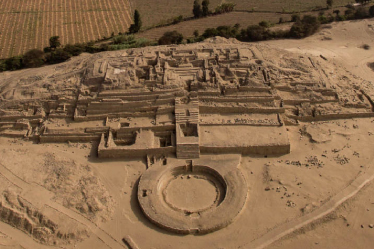The synergistic blend of rich history, vibrant culture, and ancient
ruins make Peru a top destination. Read more as a laundry list of
Wonders of the World, bucket list toppers and World Heritage Sites
than your average country guide. Here, both the well-known and
hardly-known are amongst some of the world’s most significant
cultural destinations, and UNESCO has made it official so there isn’t
a question about it. Here are the Top 12 UNESCO World Heritage
Sites in Peru to add to your list.
CULTURAL
Chan Chan Archaeological Zone
The Chimu Kingdom, with Chan Chan as its capital, reached its apogee in the 15th century, not long before falling to the Incas.The planning of this huge city, the largest in pre-Columbian America, reflects a strict political and social strategy, marked by the city’s division into nine ‘citadels’ or ‘palaces’ forming autonomous units.


Chavin
Located in the Huari Province, in the Ancash Department, around 8 hours away from the city of Lima you will find the archeological and prehistoric site of Chavín.
This place was the home of the Chavin civilization, which lived and developed from the year 1500 BC to the year 300 BC.
City of Cuzco
Situated in the Peruvian Andes, Cuzco is developed under the Inca ruler Pachacutec, into a complex urban centre with distinct religious and administrative functions. It was surrounded by clearly delineated areas for agricultural, artisan and industrial production. When the Spaniards conquered it in the 16th century, they preserved the basic structure but built Baroque churches and palaces over the ruins of the Inca city.

Historic Centre of Lima
Although severely damaged by earthquakes, this ‘City of the Kings’ was, until the middle of the 18th century, the capital and most important city of the Spanish dominions in South America. Many of its buildings, such as the Convent of San Francisco (the largest of its type in this part of the world), are the result of collaboration between local craftspeople and others from the Old World.Historical Centre of the City of
Arequipa
The historic centre of Arequipa, built in volcanic sillar rock, represents an integration of European and native building techniques and characteristics,
expressed in the admirable work of colonial masters and Criollo and Indian masons. This combination of influences is illustrated by the city’s robust walls, archways and vaults, courtyards and open spaces, and the intricate Baroque decoration of its facades. 

Lines and Geoglyphs of Nasca and
Palpa
Located in the arid Peruvian coastal plain, some 400 km south of Lima, the geoglyphs of Nazca and the pampas of Jumana cover about 450 km2. These lines, which were scratched on the surface of the ground between 500 B.C. and A.D. 500, are among archaeology’s greatest enigmas because of their quantity, nature, size and continuity. The geoglyphs depict living creatures, stylized plants and imaginary beings, as well as geometric figures several kilometers long. They are believed to have had ritual astronomical functions. Qhapaq Ñan, Andean Road System
This site is an extensive Inca communication, trade and defense network of roads covering 30,000 km. Constructed by the Incas over several centuries and partly based on pre-Inca infrastructure, this extraordinary network through one of the world’s most extreme geographical terrains linked the snow-capped peaks of the Andes – at an altitude of more than 6,000 m – to the coast, running through hot rainforests, fertile valleys and absolute deserts. It reached its maximum expansion in the 15th century, when it spread across the length and breadth of the Andes. The Qhapac Ñan, Andean Road System includes 273 component sites spread over more than 6,000 km that were selected to highlight the social, political, architectural and engineering achievements of the network, along with its associated infrastructure for trade, accommodation and storage, as well as sites of religious significance.

Sacred City of Caral-Supe
The 5000-year-old 626-hectare archaeological site of The Sacred City of Caral-Supe is situated on a dry desert terrace overlooking the green valley of the Supe river. It dates back to the Late Archaic Period of the Central Andes and is the oldest centre of civilization in the Americas. Exceptionally well-preserved, the site is impressive in terms of its design and the complexity of its architectural, especially its monumental stone and earthen platform mounts and sunken circular courts. One of 18 urban settlements situated in the same area, Caral features complex and monumental architecture, including six large pyramidal structures. A quipu (the knot system used in Andean civilizations to record information) found on the site testifies to the development and complexity of Caral society. The city’s plan and some of its components, including pyramidal structures and residence of the elite, show clear evidence of ceremonial functions, signifying a powerful religious ideology.NATURAL
Huascarán National Park
Situated in the Cordillera Blanca, the world’s highest tropical mountain range, Mount Huascarán rises to 6,768 m above sea-level. The deep ravines watered by numerous torrents the glacial lakes and the variety of the vegetation make it a site of spectacular beauty. It is the home of such species as the spectacled bear and the Andean condor.

Manú National Park
This huge 1.5 million-ha park has successive tiers of vegetation rising from 150 to 4,200 m above sea-level. The tropical forest in the lower tiers is home to an unrivalled variety of animal and plant species. Some 850 species of birds have been identified and rare species such as the giant otter and the giant armadillo also find refuge there. Jaguars are often sighted in the park.MIXED
Historic Sanctuary of Machu Picchu
Machu Picchu stands 2,430 m above sea-level, in the middle of a tropical mountain forest, in an extraordinarily beautiful setting. It was probably the most amazing urban creation of the Inca Empire at its height; its giant walls, terraces and ramps seem as if they have been cut naturally in the continuous rock escarpments. The natural setting, on the eastern slopes of the Andes, encompasses the upper Amazon basin with its rich diversity of flora and fauna.
